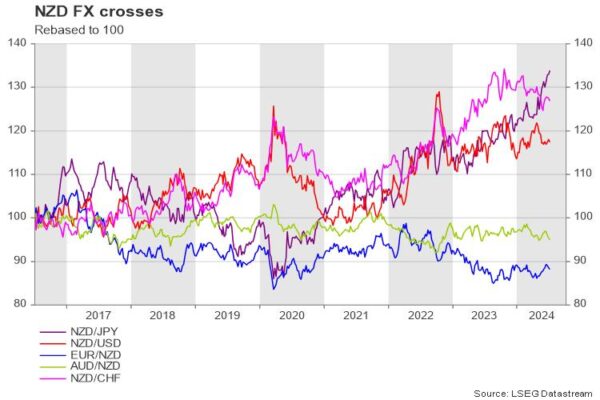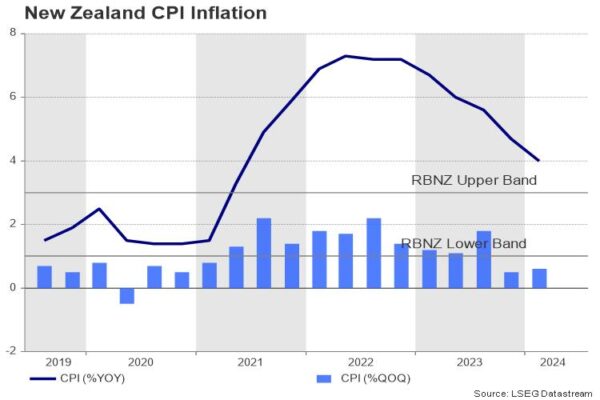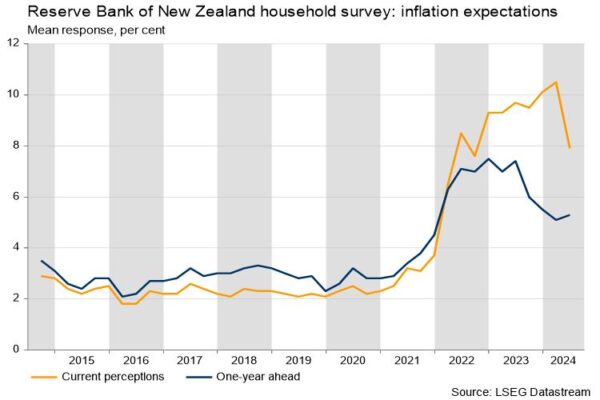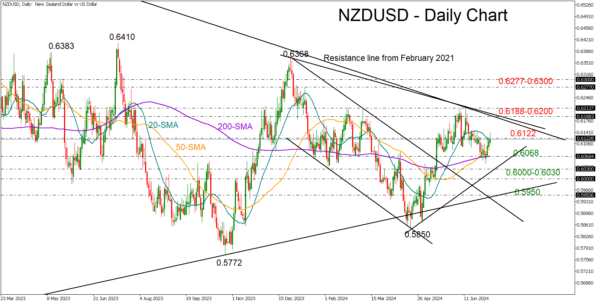- Interest rates expected to hold stable at a 15-year high of 5.5%
- NZ inflation is still problematic; will the RBNZ talk about a rate hike again?
- NZDUSD bulls have some work to do; must surpass 0.6188-0.6200 to gain more fuel
Kiwi has poor performance
The New Zealand dollar has faced difficulties this year in its exchange rate with other major currencies. Lower interest rates in Japan and Switzerland offered a minor advance to the kiwi against the yen and the swissie year-to-date, though the battle against the US dollar, the British pound, and the euro has been disappointing, resulting in a 1-3% retreat thanks to the tight rate differentials between the corresponding economies.

Inflation is still high
The problem is that, although the Reserve Bank of New Zealand (RBNZ) followed other major central banks in hiking interest rates to a multi-year high of 5.5%, headline CPI inflation has been diminishing at a relatively gradual pace, easing to 4.0% y/y in the first quarter compared to 3.6% in Australia, 3.3% in the US and 2.0% in the UK, in the most recent data. Although it’s not far from the target range of 1-3%, it is still twice the 2.0% midpoint objective and higher than what policymakers anticipated. Hence, the central bank met expectations by keeping interest rates unchanged in May, but surprisingly, it deliberated on the possibility of increasing rates, pushing back rate cut projections to the third quarter of 2025.

Investors see a rate cut this year
The hawkish policy communication led to a 5.3% rally in NZDUSD to 0.6220 in May-June, but analysts remained unconvinced about an upcoming interest rate hike. Instead, they keep pricing at least one quarter percentage reduction by the end of the year. Maybe they are correct. As the unemployment rate continues to rise and recent business surveys raise concerns about the stagnant economy, there may be little reason to increase borrowing costs.

Don’t expect meaningful policy changes
That said, the central bank is not scheduled to update its projections for the economy before its August meeting, while the next employment and inflation releases will be published in the coming weeks. Therefore, policymakers might avoid saying anything pivotal next week until they have enough evidence to justify a rate cut.
Any commentary on wage growth might also be worth paying attention to. Given the elevated inflation expectations, which suggests that demand for higher salaries could persist, it would be interesting to see if the central bank considers wage growth as a risk to inflation. If that proves to be the case, the kiwi could find some support.
In data releases, Stats NZ will publish a group of price indices on Thursday, including food and house prices, which cover 45% of the CPI, and retail card spending on Friday.

NZDUSD outlook
As regards the market reaction, the NFP report boded well for NZDUSD today. US employment increased by 206k, more than the 190k analysts estimated, though a faster-than-expected increase in the unemployment rate and a slowdown in average hourly earnings reflected weaker labor fundamentals, boosting the odds for a September rate cut to almost 80%. What remains to be seen is if Fed chief Powell sends a clear message of a rate cut during his testimony before Congress next week.
Technically, the 0.6188-0.6200 resistance zone is still intact and only a decisive close above it could elevate the price towards the 0.6277-0.6300 region.
Alternatively, if the RBNZ makes a dovish shift, calling for lower interest rates amid the weak economic climate, the pair could sink. If the 200-day simple moving average (SMA) gives way to the bears, the price could slump towards the 0.6000-0.6030 region and then to 0.5950.










